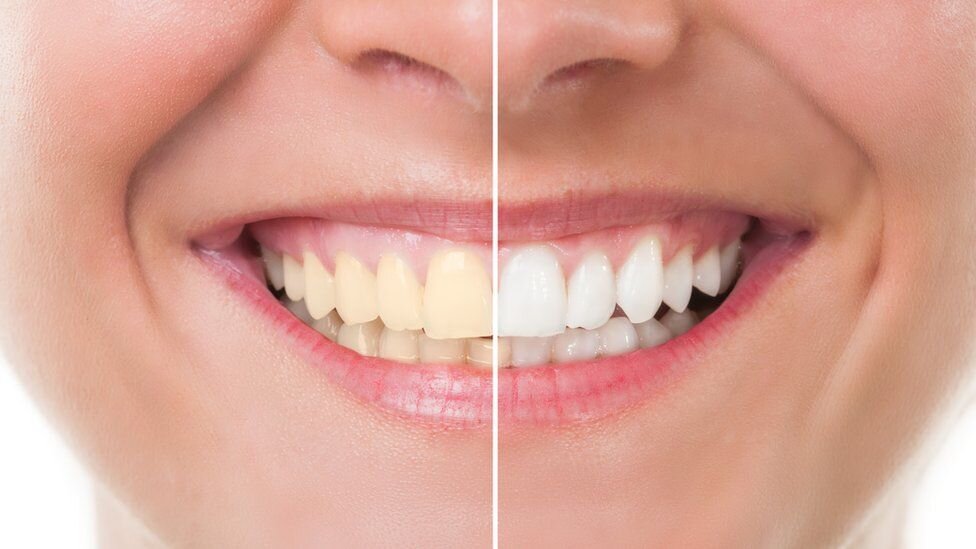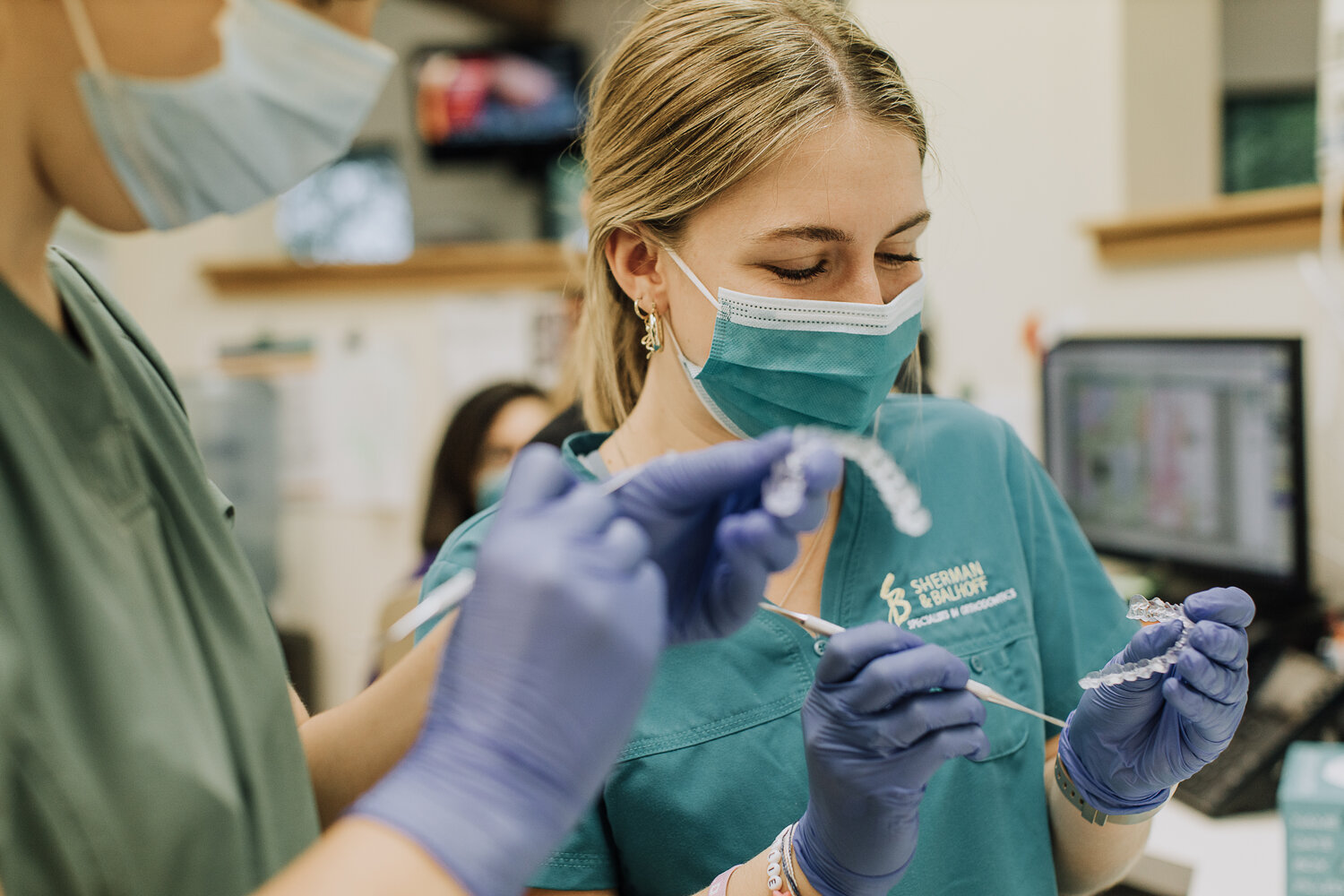Modern technology has made teeth whitening methods affordable and effective more than ever before. This billion-dollar-a-year- industry claims to help people all over the world happier with their perfect teeth, but not all teeth whitening methods are safe and/or effective.
What makes teeth look yellow? Teeth look yellow due to smoking, bruxing (grinding your teeth), staining foods and drinks, and aging enamel. If you took tetracycline antibiotics during childhood, you may have yellow teeth.

There are two basic types of teeth whitening:
-
Extrinsic whitening: Extrinsic whitening is whitening teeth by using mild abrasives to remove stains from the outer surfaces of teeth. This reveals the color underneath but does not actually change the color of teeth.
-
Intrinsic whitening: Intrinsic whitening is a teeth whitening process that uses a tooth bleaching agent to change the color of the enamel of your teeth. The only tooth whitening agent used widely is peroxide.
Some teeth whitening methods are most beneficial for preventing teeth yellowing or staining.
1. Use whitening toothpaste
Whitening toothpastes generally use a combination of ingredients to remove stains from teeth, including:
-
Carbamide or hydrogen peroxide
-
Mild abrasives (including activated charcoal, baking soda, silica, dicalcium phosphate, calcium carbonate, sodium metaphosphate, zirconium silicate, and calcium pyrophosphate)
-
Hydroxyapatite
According to a 2018 review, whitening toothpastes effectively whiten teeth and offer a brighter smile by removing surface stains.
Most whitening toothpastes, however, do not intrinsically whiten/bleach teeth.
However, hydroxyapatite (HAp) toothpaste is the only whitening toothpaste that can intrinsically whiten teeth from the inside out. It literally “fills in” the space in your enamel for a whiter, brighter appearance.
Cost: $5-30 per tube
Type: Extrinsic whitening and intrinsic whitening (HAp toothpaste only)
Pros of Whitening Toothpaste:
-
Inexpensive
-
Can intrinsically whiten teeth, in the case of HAp toothpaste
-
Does not contain enough peroxide to cause oral cancer concerns
-
HAp and fluoride toothpaste may also prevent and help to reverse tooth decay
-
HAp toothpastes are usually formulated to be safe for children (although other whitening toothpastes are not safe for children’s teeth)
Cons of Whitening Toothpaste:
-
Some toothpaste abrasives may increase the risk of cavities (choose a toothpaste with low relative dentin abrasivity to avoid this)
-
Peroxide toothpastes may cause abnormal lesions on teeth when overused
-
Peroxide may permanently destroy some of the collagen content of teeth when overused
We recommend only using an abrasive whitening toothpaste for 2-3 weeks at a time to remove tooth stains. However, hydroxyapatite toothpastes are safe for long-term use, as they don’t use strong abrasives.

2. Switch to an electric toothbrush
Electric toothbrushes remove surface stains from teeth more effectively than manual toothbrushes.
Oscillating electric toothbrushes are generally the best for teeth whitening compared to sonic-powered toothbrushes.
Electric toothbrush costs range greatly because of the “bells and whistles” they often add. There is no evidence that added features, like Bluetooth or specialized heads, improve brushing in a way that improves teeth whitening effects.
Inexpensive electric toothbrushes have similar teeth whitening benefits to those that cost hundreds of dollars.
Cost: $8-$300 (high-quality electric brushes usually cost $25-$80)
Type: Extrinsic whitening
Pros of Electric Toothbrushes:
-
Associated with no side effects or potential dangers to oral health
-
May offer better protection against tooth decay than manual brushes
Cons of Electric Toothbrushes:
-
Overbrushing is more common; may cause gum recession or tooth sensitivity if you brush too hard or too often
-
More expensive than manual toothbrushes
3. Get a professional tooth whitening treatment
For teeth whitening at your dentist’s office, expect 1-3 sessions of 30-60 minutes each.
During each session, a high concentration of carbamide or hydrogen peroxide (20-43%) will be “painted” onto the teeth. A polymerization light is used to activate the gel, and it’s reapplied several times over the session.
Although hydrogen peroxide can be used, carbamide peroxide is considered the industry standard because it has a much longer shelf life.
Some dentists will finish by using a UV light to accelerate the chemical reaction and the whitening process. You may also be offered the option to do just one 2-hour session, which will always include UV light.
Cost: $650-1250 for each session
Type: Intrinsic whitening
Pros of Professional Teeth Whitening:
-
Whitens teeth from the inside out
-
Whitens teeth fast (you’ll see whiter teeth after just one treatment)
-
Treatment and supervision by your dentist reduces the risk of damage to your teeth or gums compared to home teeth whitening systems
Cons of Professional Teeth Whitening:
-
Some of the whitening effect goes away 2-7 days after treatment
-
Added whitening effect of a UV light rebounds after 7 days or fewer
-
UV light results in greatly increased risk of sensitive teeth (and there’s no proof it actually works for more than a few days)
-
Expensive
-
Require a visit to your dentist (can’t be done at home)
Best Professional Whitening System:
No one professional whitening system is particularly better than another. Just avoid UV light!
At Sherman and Balhoff we are concerned about the health of your teeth as well as the aesthetics. Schedule a complimentary consultation today!
4. Get a custom whitening gel tray
The best, longest-lasting, most sustainable way to whiten your teeth is with custom whitening gel trays. These whitening gel trays are made and custom-fitted by your dentist based on unique impressions of your teeth.
You can keep your tray indefinitely, as long as your teeth stay in the same place. You’ll purchase whitening gel to use at home (it keeps in the fridge) anytime you want to whiten your teeth.
To use a custom whitening gel tray:
-
Remove the whitening gel from your refrigerator.
-
Squirt the peroxide gel into the tray.
-
Gently place the tray over your teeth, being careful to allow the fit to protect your gums from being exposed to the gel.
-
Leave the tray on for 1-3 hours. Do not leave it on overnight, which may cause tooth sensitivity.
Take care of a whitening tray like you would a retainer, night guard, or any oral appliance — store it in water with baking soda when not in use.
Most people achieve the results they want within 2-3 weeks of daily use, although it may take 6-8 weeks for more stubborn yellowing. Don’t whiten for multiple weeks more than once per year.
Don’t purchase over-the-counter gels above 10% concentration to use at home. Otherwise, your teeth may become very sensitive.
Cost:
-
$250-500 for custom tray
-
$20-40 for each peroxide gel refill
Pros of Custom Whitening Gel Trays:
-
Best professional results at a much lower cost than professional whitening systems
-
May be included as a part of Invisalign treatment
-
With 10% peroxide gels, you shouldn’t experience tooth sensitivity
-
Won’t damage your sensitive gum tissue because the tray protects soft tissue in the mouth

Cons of Custom Whitening Gel Trays:
-
Higher peroxide gel percentages (over 10%) may result in tooth sensitivity or even damage to the tooth pulp
-
Require 2 initial visits to your dentist
Best Custom Whitening Gel Trays:
We create custom 3D scans, using our iTero scanner, of our patients teeth and print retainers that are custom for your mouth!
5. Apply whitening strips
Whitening strips are small pieces of a flexible plastic coated with a whitening gel.
To use these products, like Crest Whitestrips, a strip for the bottom and one for the top are molded around the teeth and left for 5-30 minutes. Most whitestrips are intended for use over a few weeks, but some Crest Whitestrips can whiten teeth at home in one day.
Because peroxide and the adhesives in most whitestrips can damage or irritate sensitive gum tissue, it’s best to cut the strips down before use.
Some more “natural” whitening strips do not use bleaching products but use other whitening agents to remove stains. These other agents do not whiten teeth intrinsically.
The gel in whitestrips shouldn’t come into contact with tooth decay, so it’s best to use these teeth whiteners shortly after a dental visit to ensure you have no untreated cavities.
Cost: $13-60, depending on strength and brand
Type: Intrinsic (peroxide-based whitestrips) and extrinsic whitening (non-peroxide whitestrips)
Pros of Whitening Strips:
-
Readily available at drugstores and on Amazon
-
Easy to use
-
Create results within a few days or weeks
-
Crest 3D Glamorous White Whitening Strips are approved by the American Dental Association (ADA)
Cons of Whitening Strips:
-
May cause uneven whitening results if not applied perfectly (especially if your teeth aren’t straight)
-
May lead to soft tissue damage in the mouth from free radical reactions
-
Can increase tooth sensitivity
-
May cause excruciating pain if applied to a tooth with an open cavity
6. Use baking soda toothpaste
Baking soda (sodium bicarbonate) is an effective home remedy for yellowing teeth.
Research indicates that toothpastes that contain baking soda remove stains from yellowing teeth more effectively than other pastes. The higher the concentration of baking soda, the better the results.
While you can look for toothpastes that include baking soda, the easiest way to implement this is to DIY it:
-
Mix 2 teaspoons of water with a teaspoon of baking soda.
-
Dip your brush in the mixture.
-
Brush your teeth as normal.
Cost: $1-$30, depending on the brand of baking soda or baking soda toothpaste
Type: Extrinsic whitening
Pros of Baking Soda:
-
Inexpensive
-
Widely available for purchase
-
Easy to use in DIY toothpaste formulas
-
Non-toxic to the mouth
-
Only mildly abrasive, especially compared to most whitening toothpaste abrasives (contrary to popular belief)
-
Removes plaque to protect against tooth decay
Cons of Baking Soda:
-
Will not be as effective on its own as in a full toothpaste formulation (baking soda is best for whitening and enamel strength when combined with fluoride and hydrogen peroxide)
7. Try oil pulling
Oil pulling may remove some surface stains from teeth, but it isn’t a very effective teeth whitener. However, it will balance the oral microbiome and reduce inflammation of bleeding gums/gingivitis.
Coconut oil does have the ability to bind to bacteria on the teeth and, therefore, remove some surface stains. But oil pulling will not “whiten” teeth any more than swishing your mouth regularly with water.
However, since oil pulling is so good for oral hygiene in general, I include it on this list as a combo method of stain removal and stain prevention.
Cost: $3-18
Type: Some extrinsic whitening, preventative
Pros of Oil Pulling:
-
Beneficial to overall oral health
-
Reduces the risk of plaque buildup on teeth, which could cause teeth yellowing
-
No known common side effects
Cons of Oil Pulling:
-
Can’t actually whiten teeth; more a “preventative” measure to avoid plaque buildup
-
In extremely rare cases, has been connected with lipid pneumonia
-
Can clog water pipes if spit into the sink (always spit used coconut oil into the trash can)
8. Practice good oral hygiene
Everyone’s teeth yellow somewhat over time — it’s a normal part of aging. However, the best way to prevent your teeth from changing color rapidly is good oral hygiene.
A word of caution: Any oral hygiene routine that involves antibacterial products is bad for the oral microbiome. Avoid or greatly limit your use of antibacterial mouthwash, antibacterial toothpaste, essential oils, and hydrogen peroxide mouth rinses.
The best oral hygiene routine involves:
-
Brushing your teeth at least twice per day and 45 minutes after meals containing sugary, acidic, or processed foods
-
Flossing at least once a day
-
Scraping your tongue every day
-
Oil pulling with coconut oil
-
Dental probiotics, especially if you have existing oral problems like bad breath, cavities, or bleeding gums
Type: Extrinsic whitening, preventative
Pros of Good Oral Hygiene:
-
Healthy teeth age slower than unhealthy teeth with weakened enamel, which means they yellow at a slower rate.
-
Brushing teeth not only keeps them healthy on the inside, but the outside (preventing surface stains from forming).
-
Maintaining a healthy oral microbiome prevents not only plaque buildup — which discolors teeth — but also gum disease, which can lead to tooth loss.
9. Don’t skip dental checkups
Getting a teeth cleaning every 6 months is a very important part of preventing tooth stains and yellowing.
Your hygienist will remove tartar from your teeth, which can’t be removed at home. This tartar could otherwise lead to cavities, gum disease, and even painful tooth abscesses. Plus, removing tartar improves the color of your teeth.
In addition to your bi-yearly cleaning, your dentist will examine your teeth for issues. He or she isn’t just looking for white teeth — they’re making sure you have no oral disease that could age or otherwise harm your dental health.
Cost: $100-200 per visit, depending on your location (usually covered by dental insurance)
Type: Extrinsic whitening, preventative
Pros of Dental Checkups:
-
Important for overall oral health
-
Removes yellow tartar and plaque buildup
-
Allows your dentist to catch oral disease that could otherwise yellow or damage teeth
10. Prevent teeth stains caused by food
Certain acidic foods or highly pigmented drinks can cause tooth stains. To avoid teeth stains from these foods and drinks, limit your intake and rinse your mouth with water after eating or drinking them.
Then, 45 minutes after rinsing with water, brush your teeth.
Foods and beverages that stain your teeth include:
-
Red wine
-
Berries (blackberries, blueberries, etc.)
-
Pomegranates
-
Regular and diet soda
-
Black tea
-
Curry
-
Marinara sauce
-
Turmeric
-
Balsamic vinegar
Type: Preventative
11. Quit smoking & tobacco use
Tobacco products, including cigarettes, cause external tooth staining and age (yellow) teeth prematurely. Smoking other products, like vape pens or THC, can result in dry mouth, which also ages tooth enamel and leads to poor oral health.
To prevent damage to your teeth, including yellowing and weakened enamel, stop smoking and using all tobacco products.
Type: Preventative
12. Get veneers
If you have permanent damage to your teeth, including discoloration that can’t be fixed, talk to your dentist about veneers.
Veneers are permanent, artificial tooth coverings that can replace the appearance of permanently damaged teeth without the expense and procedures of dental implants.
Veneers aren’t exactly a teeth whitening method, but rather cover your natural teeth. You and your dentist will choose a tooth color for veneers because you can’t whiten them later.
Cost: $19,200 on average for a full set of veneers
Type: Restorations
Pros of Veneers:
-
Can completely change the appearance of yellow teeth
-
Permanent solution for white teeth
Cons of Veneers:
-
Can be prohibitively expensive
-
Do not last forever
-
Require permanent alteration to natural teeth shape (cannot be reversed)
Avoid These Teeth Whitening Methods
Some teeth whitening products and methods are dangerous and/or do not work. As a dentist for 33+ years, I’ve seen some truly concerning results from ineffective or harmful teeth whitening.
Avoid using the below teeth whitening methods:
-
UV, LED, laser, or halogen teeth whitening systems: These light-based whitening products do not improve teeth whitening more than non-UV systems. They can cause tooth sensitivity and potentially devitalize tooth nerves, requiring restorations like root canal therapy or tooth extraction. If your teeth whitening kit comes with a light, throw the light away.
-
Kiosk teeth whitening: Many malls have teeth whitening “kiosks” where untrained people administer teeth whitening products. Companies such as these get around any legal constraints by having consumers themselves place the whitening tray into their mouths. This means that, under the law, they haven’t technically performed a dental procedure and aren’t responsible for the side effects or issues that may result. Avoid these at all costs.
-
Whitening mouthwash: Rinsing with a hydrogen peroxide mouthwash won’t whiten your teeth. Bleaching agents need to be held up against the tooth for several minutes or more to seep into the inner part of the tooth and lead to whiter teeth. There’s not enough peroxide to whiten your teeth, and the agent isn’t against your teeth for long enough. Plus, some hydrogen peroxide rinses and most over-the-counter mouthwashes will harm your oral microbiome.
-
Acidic fruits: Fruits like strawberries, lemons, and pineapples are often touted as great DIY teeth whitening methods. The fruit’s acid wears away the top layer of enamel, revealing whiter enamel underneath. You’ll get moderate tooth whitening results, but at a cost to the health of your teeth. Plus, these DIY methods aren’t as effective at whitening your teeth as other options.
-
Apple cider vinegar: Apple cider vinegar (ACV) is an extremely acidic natural remedy that contains good probiotics that can benefit gut health. However, it’s not a good idea to whiten your teeth with ACV. It will break down your tooth enamel, cause sensitive teeth, and may even lead to tooth decay.
-
Sea salt: While mild-to-moderate abrasives are helpful for whitening teeth, sea salt will physically scratch your teeth if rubbed onto enamel. This is extremely dangerous! Keep the salt for a rinse to treat your toothache, not as a teeth whitening solution.
In Summary: What is the best way to whiten teeth?
The best way to whiten teeth by removing stains is whitening toothpaste and an electric toothbrush. For more dramatic results, the best teeth whitening method is a custom-fitted whitening gel tray.
While many people aim for the sparkliest smile they can achieve, whiter teeth don’t actually equal healthier teeth. That said, there’s nothing wrong with trying a safe teeth whitening method if you’re not happy with the color of your teeth.
Schedule A Complimentary Consultation Today

